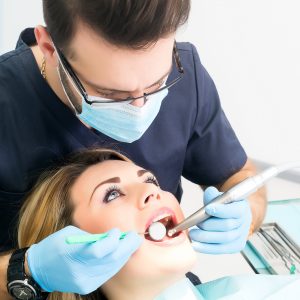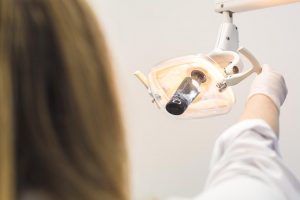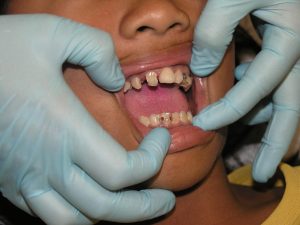
A recent technology, CAD/CAM technology (computer-aided design/manufacturing technology) has evolved to display a 3-D picture of the teeth. A restoration is then created through milling of a ceramic block.
After your new crown has been placed, your dentist will provide you with information about caring for your new restoration. In general, maintain proper oral hygiene habits by brushing twice daily and flossing with dental floss or interdental cleaners (specially designed brushes and sticks) once a day. These practices will help to remove plaque from the area where the crown meets the gum, and help prevent dental decay and gum disease.
Avoid chewing hard foods, ice or other hard objects, since this could damage your crown. It also is important to avoid biting your fingernails and grinding your teeth, which could significantly shorten its life-span. If you habitually clench or grind your teeth, your dentist may recommend wearing a night-time mouth guard to offer protection while sleeping.
If you, your family or friends need dental care, we would be honored to provide you with state-of-the-art dental care in our modern dental practice. Refer someone you love to someone you trust!
Presented as a service to the community by Doctors Hoover and Yanda,
39 Milford Drive, Hudson, Ohio 44236. 330-650-0360. www.drshooverandyanda.com

 Dental crowns, also known as “caps,” preserve the functionality of damaged teeth. This common dental restoration may be used to protect a cracked tooth, restore functionality of a tooth with excessive decay or replace a pre-existing crown. It protects a weakened tooth with a custom-designed material.
Dental crowns, also known as “caps,” preserve the functionality of damaged teeth. This common dental restoration may be used to protect a cracked tooth, restore functionality of a tooth with excessive decay or replace a pre-existing crown. It protects a weakened tooth with a custom-designed material. When your treatment plan calls for direct composite restorations or adhesively bonded restorations, dentists start the process by isolating the teeth, to prevent interference from moisture. Depending on the extent of the treatment, anesthetic injections may be required.
When your treatment plan calls for direct composite restorations or adhesively bonded restorations, dentists start the process by isolating the teeth, to prevent interference from moisture. Depending on the extent of the treatment, anesthetic injections may be required. The term bonding is used in dentistry to describe adhering dental materials to your teeth using specialized adhesives and a high-intensity curing light.
The term bonding is used in dentistry to describe adhering dental materials to your teeth using specialized adhesives and a high-intensity curing light. To determine if your dental problems can be solved with direct composite bonding, your dentist first will conduct a thorough examination and evaluation of your teeth and gums. During your consultation, your dentist will discuss the clinical and cosmetic problems that direct composite bonding can resolve, such as cavities, chips, cracks, fractures, gaps and spaces between teeth, and tooth discoloration. However, if you have teeth that are extensively damaged or your dentist feels other dental issues may affect the success and longevity of direct composite bonding treatment, other options may be presented to you, such as crowns or veneers.
To determine if your dental problems can be solved with direct composite bonding, your dentist first will conduct a thorough examination and evaluation of your teeth and gums. During your consultation, your dentist will discuss the clinical and cosmetic problems that direct composite bonding can resolve, such as cavities, chips, cracks, fractures, gaps and spaces between teeth, and tooth discoloration. However, if you have teeth that are extensively damaged or your dentist feels other dental issues may affect the success and longevity of direct composite bonding treatment, other options may be presented to you, such as crowns or veneers. Enamel loss is a common component of tooth decay and may result in tooth sensitivity. In many cases, sensitivity caused by enamel loss will be significantly improved or completely eliminated once an appropriate dental filling material is placed.
Enamel loss is a common component of tooth decay and may result in tooth sensitivity. In many cases, sensitivity caused by enamel loss will be significantly improved or completely eliminated once an appropriate dental filling material is placed. Composite fillings are usually more expensive than traditional amalgam fillings because they require a more sophisticated process, more expensive materials and additional office equipment. Composite materials offer an aesthetic alternative to traditional amalgam materials. Because composites can be bonded to teeth, they provide a better seal against leakage and further decay. As such, people who have previously received amalgam fillings often return to their dentist to have them replaced with composite.
Composite fillings are usually more expensive than traditional amalgam fillings because they require a more sophisticated process, more expensive materials and additional office equipment. Composite materials offer an aesthetic alternative to traditional amalgam materials. Because composites can be bonded to teeth, they provide a better seal against leakage and further decay. As such, people who have previously received amalgam fillings often return to their dentist to have them replaced with composite. Composite fillings are usually more expensive than traditional amalgam fillings because they require a more sophisticated process, more expensive materials and additional office equipment. Composite materials offer an aesthetic alternative to traditional amalgam materials. Because composites can be bonded to teeth, they provide a better seal against leakage and further decay. As such, people who have previously received amalgam fillings often return to their dentist to have them replaced with composite.
Composite fillings are usually more expensive than traditional amalgam fillings because they require a more sophisticated process, more expensive materials and additional office equipment. Composite materials offer an aesthetic alternative to traditional amalgam materials. Because composites can be bonded to teeth, they provide a better seal against leakage and further decay. As such, people who have previously received amalgam fillings often return to their dentist to have them replaced with composite. One of the more common oral health issues discovered during scheduled cleanings is dental caries (tooth decay). Your dentist will examine your teeth using a dental instrument called an explorer and may also take an X-ray to determine the extent and exact location of the cavity and decay. In our office, we also use a laser to help detect decay.
One of the more common oral health issues discovered during scheduled cleanings is dental caries (tooth decay). Your dentist will examine your teeth using a dental instrument called an explorer and may also take an X-ray to determine the extent and exact location of the cavity and decay. In our office, we also use a laser to help detect decay. Always ask your dentist if you’re not sure how your nutrition (diet) may affect your oral health. Conditions such as tooth loss, pain or joint dysfunction can impair chewing and are often found in elderly people, those on restrictive diets and those who are undergoing medical treatment. People experiencing these problems may be too isolated or weakened to eat nutritionally balanced meals at a time when it is particularly critical. Talk to your dental health professional about what you can do for yourself or someone you know in these circumstances.
Always ask your dentist if you’re not sure how your nutrition (diet) may affect your oral health. Conditions such as tooth loss, pain or joint dysfunction can impair chewing and are often found in elderly people, those on restrictive diets and those who are undergoing medical treatment. People experiencing these problems may be too isolated or weakened to eat nutritionally balanced meals at a time when it is particularly critical. Talk to your dental health professional about what you can do for yourself or someone you know in these circumstances.